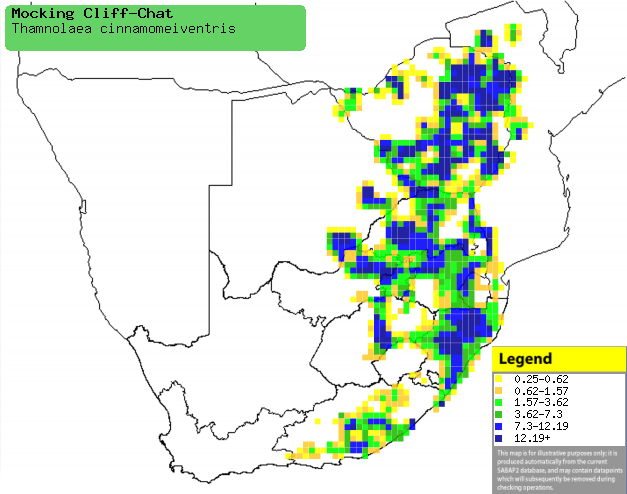|
Thamnolaea cinnamomeiventris (Mocking
cliff-chat, Mocking chat)
Dassievoël [Afrikaans]; iQumutsha-lamawa
[Zulu]; Roodbuik-kliftapuit [Dutch]; Traquet à ventre roux [French];
Rotbauchschmätzer [German]; Chasco-poliglota [Portuguese]
Life
> Eukaryotes >
Opisthokonta
> Metazoa (animals) >
Bilateria >
Deuterostomia > Chordata >
Craniata > Vertebrata (vertebrates) > Gnathostomata (jawed
vertebrates) > Teleostomi (teleost fish) > Osteichthyes (bony fish) > Class:
Sarcopterygii (lobe-finned
fish) > Stegocephalia (terrestrial
vertebrates) > Tetrapoda
(four-legged vertebrates) > Reptiliomorpha > Amniota >
Reptilia (reptiles) >
Romeriida > Diapsida > Archosauromorpha > Archosauria >
Dinosauria
(dinosaurs) > Saurischia > Theropoda (bipedal predatory dinosaurs) >
Coelurosauria > Maniraptora > Aves
(birds) > Order: Passeriformes
> Family: Muscicapidae
Distribution and habitat
Occurs in a neat band from central Ethiopia through
Tanzania, Malawi and northern Mozambique to southern Africa. Here it is locally
common in Zimbabwe, south-eastern Botswana, the eastern half of South Africa and
southern Mozambique. It generally prefers well-wooded rocky ravines, cliffs and
gullies, boulder-strewn hillsides and watercourses in valley bottoms with
scattered rocks.
|
 |
|
Distribution of Mocking cliff-chat in southern Africa,
based on statistical smoothing of the records from first SA Bird Atlas
Project (©
Animal Demography unit, University of
Cape Town; smoothing by Birgit Erni and Francesca Little). Colours range
from dark blue (most common) through to yellow (least common).
See here for the latest distribution
from the SABAP2. |
Movements and migrations
Resident throughout most of its distribution,
although in the Drakensberg it tends to head to lower altitudes in
winter.
Food
It eats insects, fruit and occasionally the nectar of
aloes, such as Krantz aloe (Aloe arborescens). It does most of its
foraging from a perch, pouncing on prey on the ground, but it may also glean
food from leaves and branches.
Breeding
- The nest is built by both sexes in about a week, consisting of an open cup
set into a foundation of twigs, leaves, roots and feathers, lined with the
hair of antelopes and hyraxes. It is typically placed in the nest of a
striped swallow, sometimes kicking them out while they are in the process of
breeding, usually position beneath a rock overhang, bridge, culvert or in a
cave. It may occasionally use a hole in a wall or a cavity in agricultural
machinery.
- Egg-laying season is from August-December, peaking from
September-November.
- It lays 2-4 eggs, which are incubated solely by the female for about
14-16 days.
- The chicks are fed by both parents, leaving the nest after about 19-21
days.
Threats
Not threatened.
References
-
Hockey PAR, Dean WRJ and Ryan PG 2005. Roberts - Birds of
southern Africa, VIIth ed. The Trustees of the John Voelcker Bird Book
Fund, Cape Town.
|
